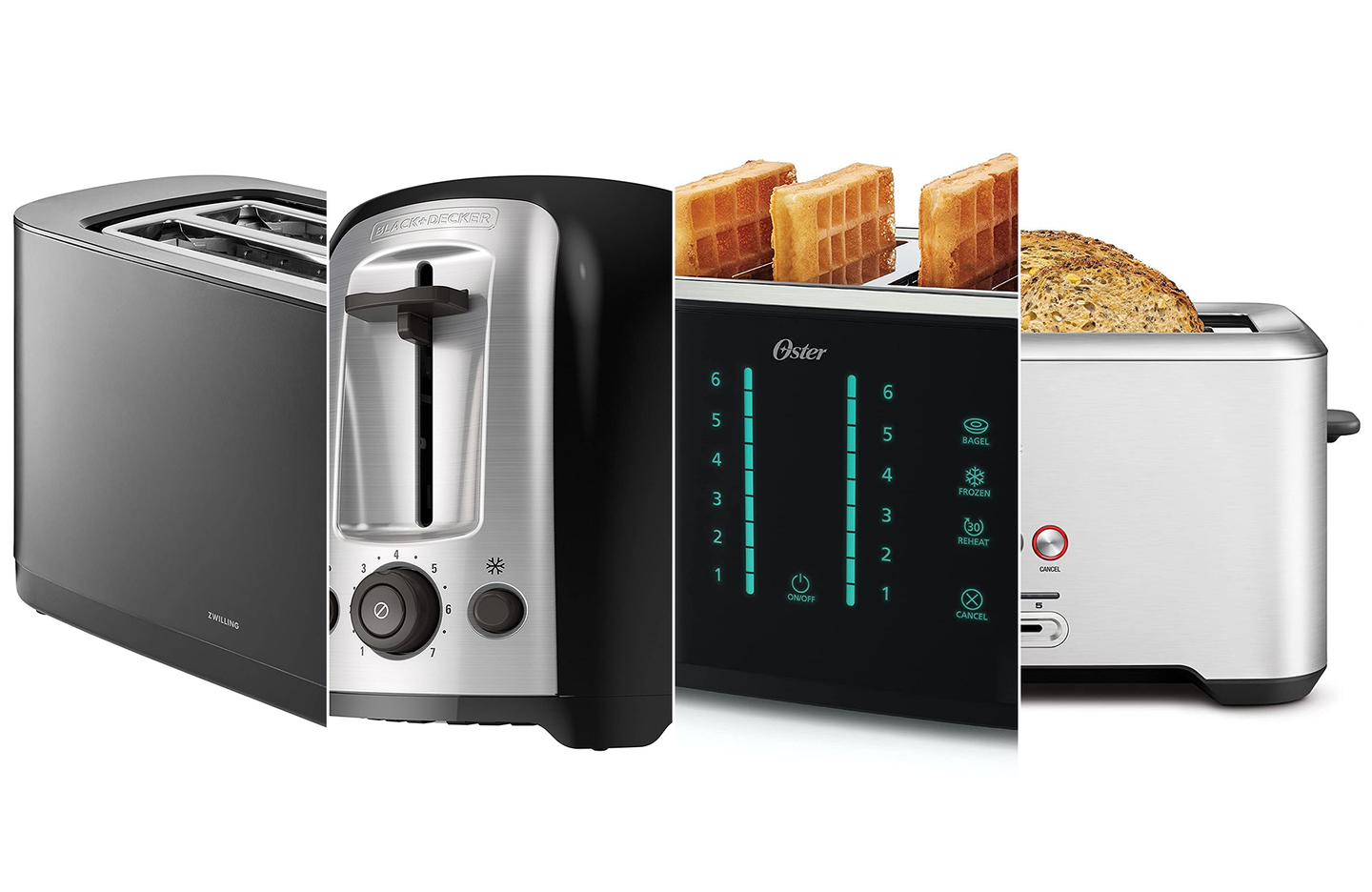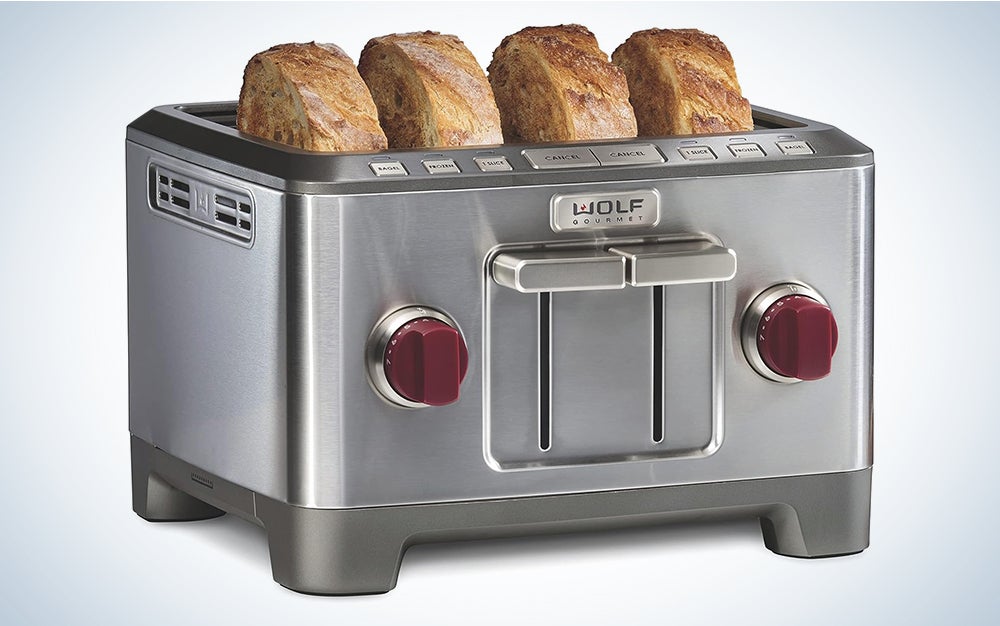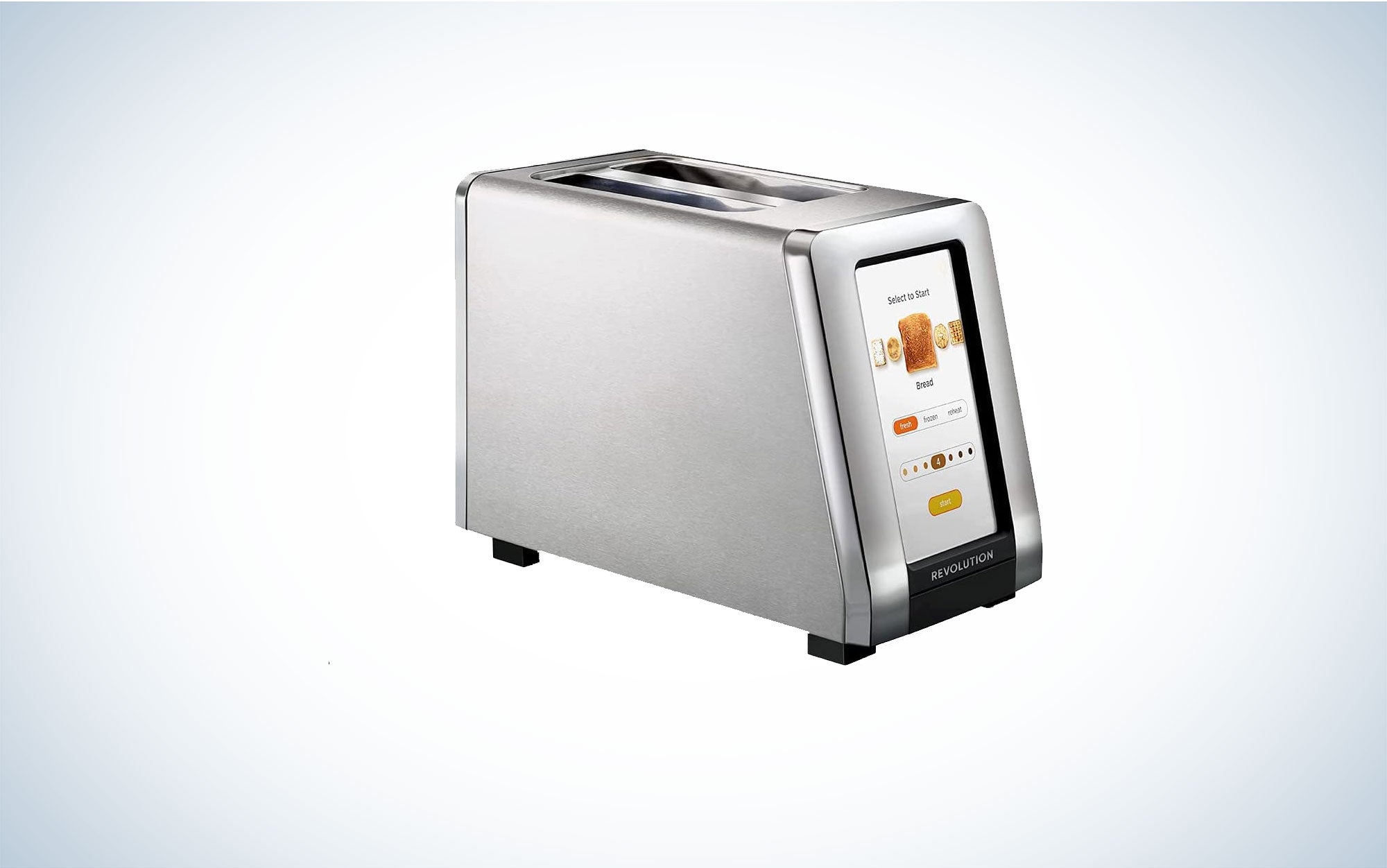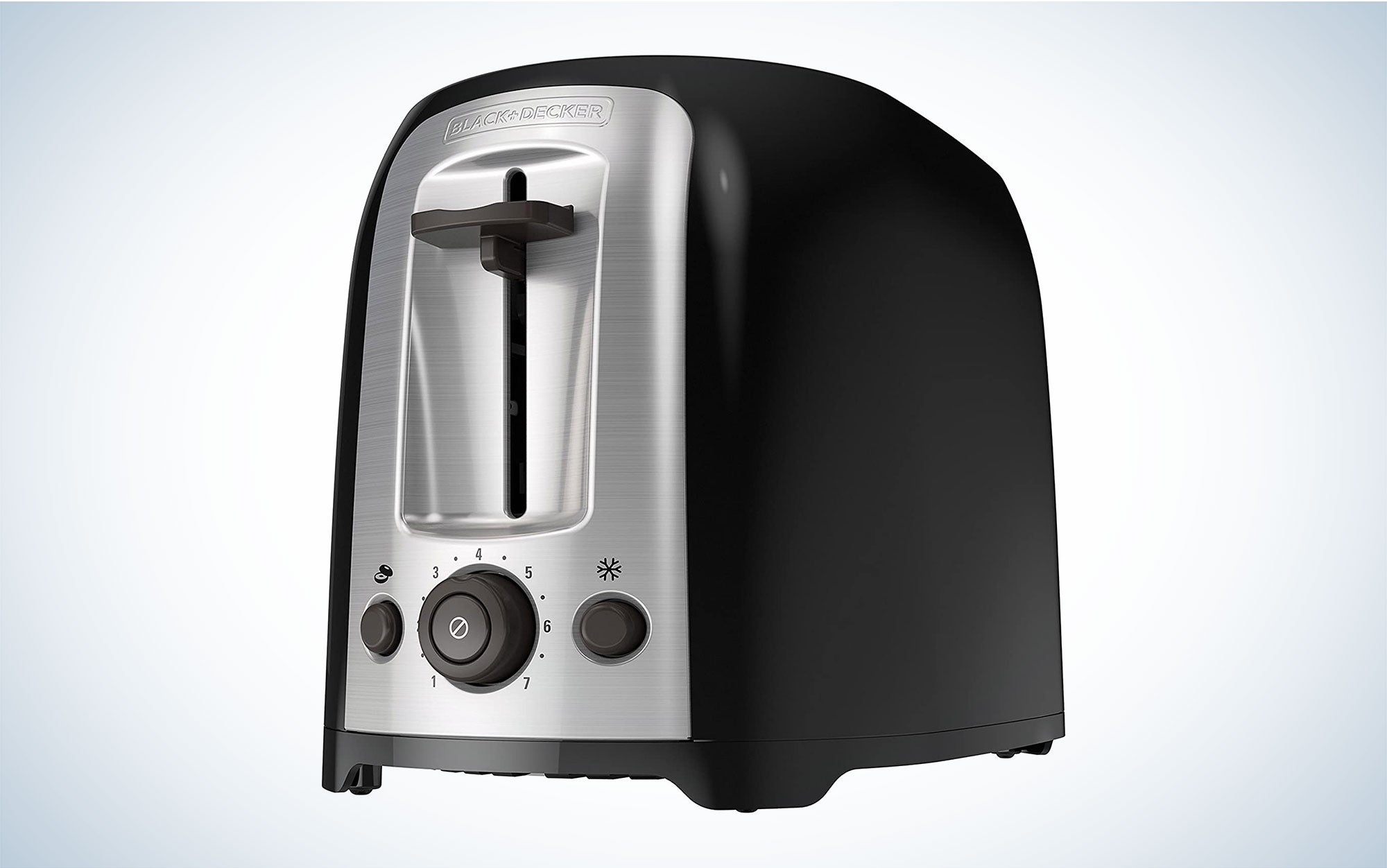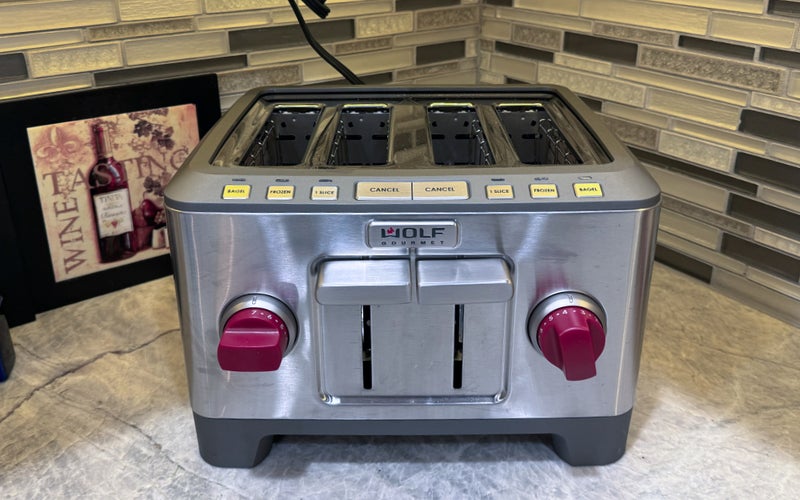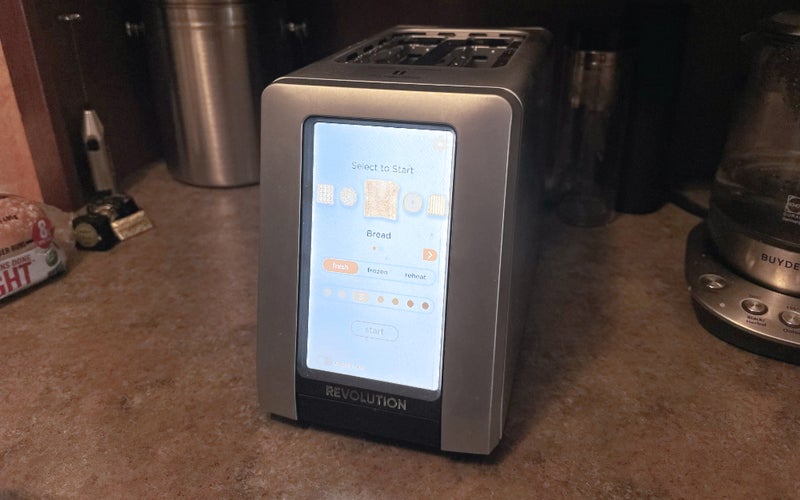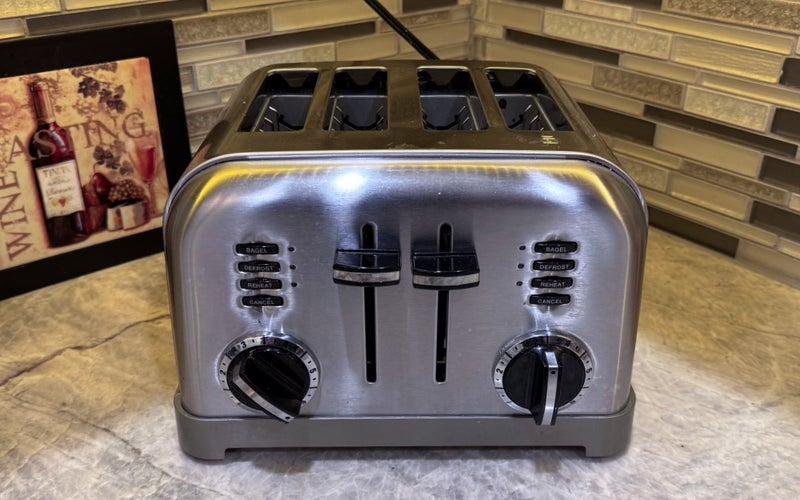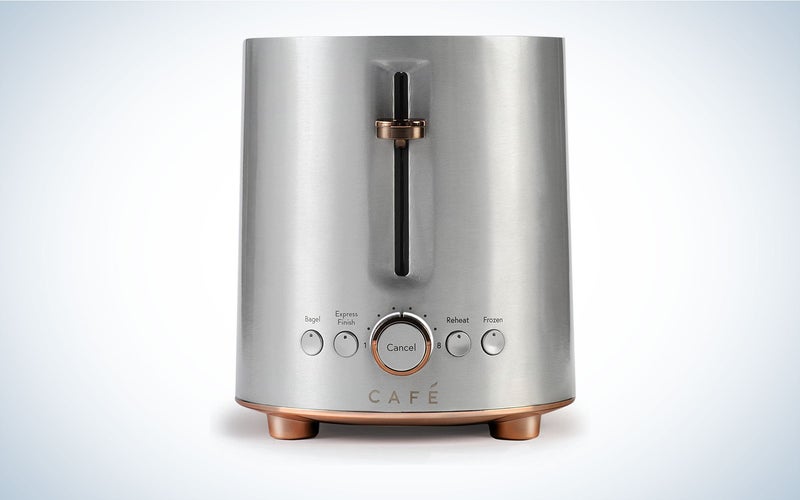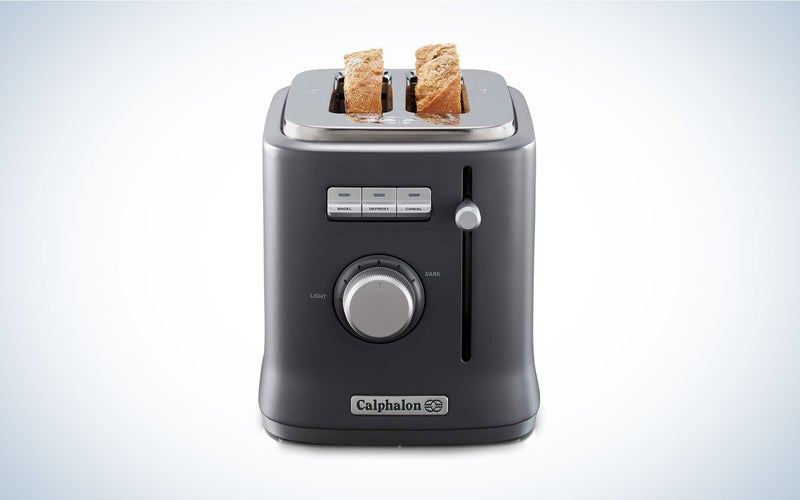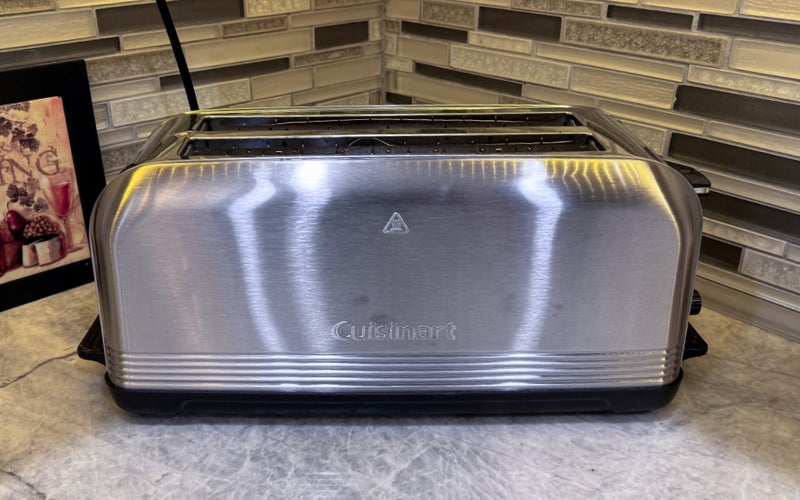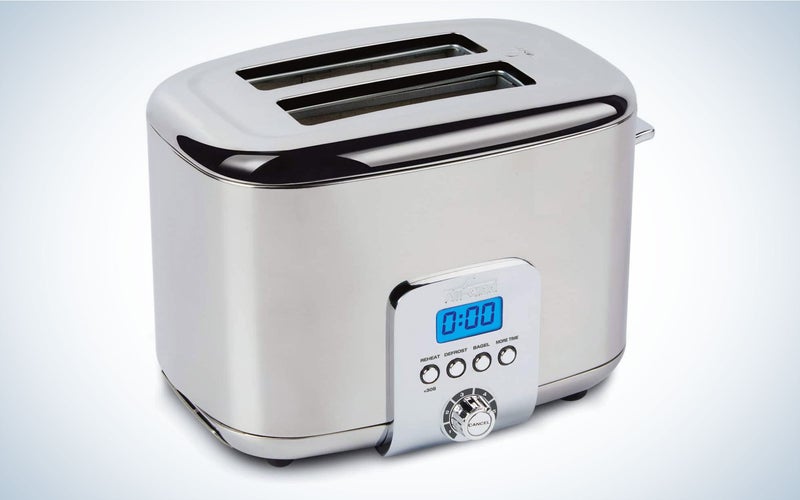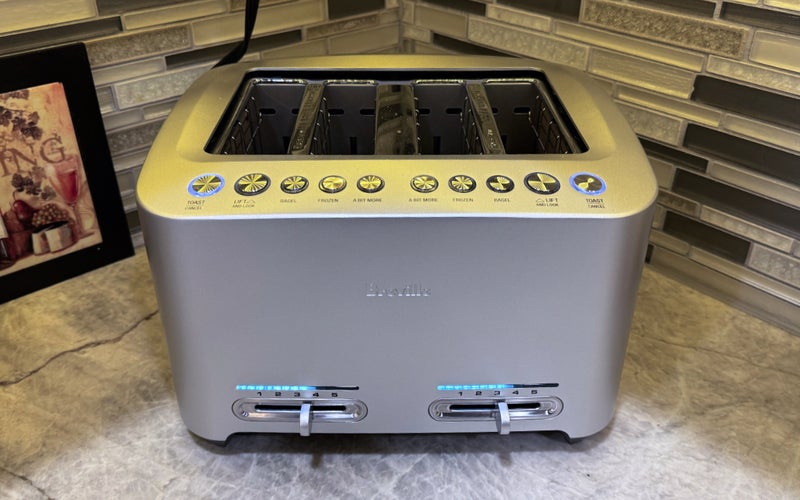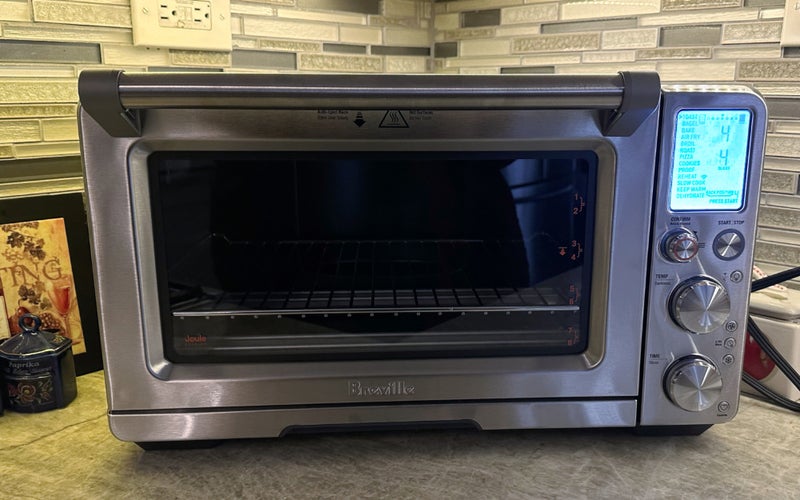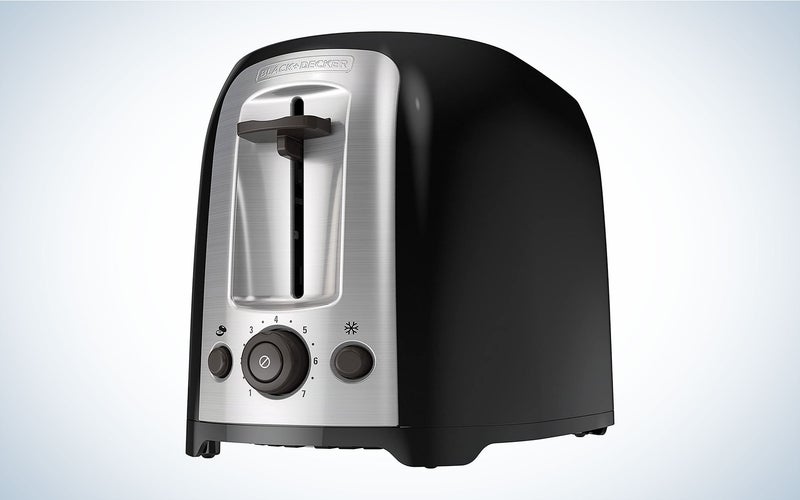We may earn revenue from the products available on this page and participate in affiliate programs. Learn more ›
Toasters have been a mainstay in kitchens for decades—and for good reason. Bread is a staple in our breakfasts, lunches, and midnight snacks, and toasting makes us love it more. We love crisp, golden-brown carbs so much that companies have created foods specifically to be toasted: Pop-Tarts, grocery-store English muffins, and frozen waffles, among others. And, of course, heat can also refresh aging bread. The quest for perfect toast has to start with finding the best toasters, and these are the top ones we’ve found to date.
- Best overall: Wolf Gourmet 4-Slice Extra-Wide Slot Toaster
- Best smart toaster: Revolution R180 InstaGLO Toaster
- Best 4-slice: Cuisinart Metal Classic 4-Slice Toaster
- Best for fast toasting: Café Express 2-Slice Toaster
- Best for bagels: Calphalon Precision 2-Slice Toaster
- Best long slot: Cuisinart CPT-2500 Long Slot Toaster
- Best with a timer: All-Clad Stainless Steel Digital Toaster
- Best design: Breville Die-Cast Smart Toaster
- Best toaster oven: Breville Smart Oven Air Fryer Pro
- Best budget: Black & Decker 2-Slice Extra-Wide Slot Toaster
How we chose the best toasters
As a freelance journalist for over 10 years, I’ve reviewed home and tech products for publications such as CNN Underscored, NBC News Select, Popular Mechanics, Architectural Digest, Tom’s Guide, The Daily Beast, USA Today’s Reviewed, Apartment Therapy, The Spruce, and Bob Vila. I combined my experience with that of other PopSci writers, and we compiled our extensive selections based on personal testing, thorough research, recommendations from fellow critics, and user impressions.
The best toasters: Reviews & Recommendations
There are hundreds—if not thousands—of toasters. Picking just one assertively and with confidence can be a challenge. We’ve narrowed the choices down to just a few that we consider the best toasters. One of these should have you spreading grape jam on golden bread in no time.
Best overall: Wolf Gourmet 4-Slice Extra-Wide Slot Toaster
Brandt Ranj / Popular Science
Why it made the cut: This toaster can fit any size of bread, toast it well, and serve it up to you (minus the platter).
Specs
- Dimensions: 14.75 x 14.5 x 11.3 inches
- Weight: 13.22 pounds
- Slots: 4
- Material: Stainless Steel
- Crumb tray: Yes
- Settings: Bagel, frozen, one slice
Pros
- Superlative build quality
- Consistent toasting
- Can accommodate extra thick slices of bread
Cons
- Expensive
If you want the best toast, it’s going to cost you, but the results spoke for themselves. Wolf Gourmet’s Toaster is not only the best choice in its class, it’s one of the best kitchen appliances we’ve ever tested. We immediately noticed the toaster’s build quality—it’s quite a bit heavier than any other we tested—from the amount of tension in its knobs, the clinkiness of its buttons, and its serious-looking tines. The toaster grabbed onto toast, bagels, or waffles more tightly than other toasters before lowering it to its heating elements. The tines themselves are thick, which gives the literal impression of grill marks on whatever’s being toasted.
Wolf Gourmet’s toaster produced the most consistent results of any toaster we tested, with noticeable increases in browning as we increased its heating settings. It didn’t matter what type of toast or starch we were cooking; the toaster never let us down. It also performed the best at the highest heating setting, as what emerged from the toaster was still edible rather than being an overly charred hockey puck-looking mess. The toaster’s slots were also a fair bit wider than most other models, which means it can accommodate thicker slices of sourdough or heartier bagels.
At $399, Wolf Gourmet’s Toaster is the most expensive one we’re recommending, but it’s well worth the added cost if you make toast, bagels, English muffins, or similar starches daily. You’ll always get exactly what you expect, with no stuck slices that necessitate careful cajoling with a butter knife to get loose.
Best smart toaster: Revolution R180 InstaGLO Toaster
Brandt Ranj / Popular Science
Why it made the cut: The Revolution R180 InstaGLO does everything but wash your dishes. Maybe that’s the next upgrade?
Specs
- Dimensions: 11.65 x 6.13 x 8.4 inches
- Weight: 7.83 pounds
- Slots: 2
- Material: Stainless steel
- Crumb tray: Yes
- Settings:
Pros
- Touchscreen instead of levers and dials
- Toasts faster
- Smartphone control
- Clean crumb tray reminder
- Doubles as a sleek clock
- Accessories for Panini press/warming rack
Cons
- Extremely expensive
- Only comes in a 2-slice model
Admittedly, $350 is a lot of money for a toaster—but the Revolution InstaGLO R180 is no ordinary toaster. It has a touchscreen interface that visualizes all of the controls: There are no levers to push down, no knobs or dials to turn. It has a countdown timer, so you can check how long until your toast is done, in addition to the usual chime. Select the bread type from the icons; select fresh, frozen, or reheat; select toasting level from one of the seven settings; and then press start. The screen even lets the toaster serve as a stainless-steel digital clock between uses.
The Revolution InstaGLO R180’s interface is pretty simple to use, but it still took some time for us to get used to it. The idea of operating a toaster with no physical buttons may seem absurd, but its visual indicators give you a sense of what your toast will look like at seven stages of doneness. If you like your toast well done but not burnt, you’ll be able to dial that setting in with a few taps. Selecting fresh, frozen, or reheat made a big difference in the results, too. We weren’t surprised by the Revolution InstaGLO R180’s performance when toasting room-temperature white and whole wheat bread—it costs $350, and this is its core function—but we really liked how it handled frozen bread. If you keep your bread in the freezer to extend its freshness, you can expect perfect toast every time without waiting much longer
One of our favorite features of the Revolution InstaGLO R180 is its countdown timer, which will let you know exactly how much time is left in the toasting process. The first three-quarters of your toasting will be represented by dots appearing in a circle, like a loading bar on your computer. When it reaches the end, a timer will actually start counting down until it’s done. Easily checking how much time is left until you’ve got toast is an excellent feature, and any smart toaster will need to adopt it to retain relevance.
Most toasters can be used to make the essentials—toast, bagels, toaster pastries, English muffins—but optional accessories allow you to expand the Revolution InstaGLO R180’s functionality. A panini press will allow you to make stuffed sandwiches like grilled cheese in the toaster without the risk of damaging its coils. InstaGLO R180’s warming rack will provide a surface to slightly toast the bottom of pasties that wouldn’t fit in its slots.
Other features, like the Revolution InstaGLO R180’s ability to automatically adjust the lift to the height of whatever is being toasted, are subtle but welcome touches. There’s even a smart reminder that displays on the screen when you need to empty the crumbs at the bottom, and the catch tray releases with a simple push. It really feels like using a toaster from the future. Whether the future is worth $350 is debatable, but Revolution InstaGLO R180’s smart features aren’t superfluous. This isn’t a smart kitchen gadget whose flashy features mask poor performance.
Best 4-slice: Cuisinart Metal Classic 4-Slice Toaster
Brandt Ranj / Popular Science
Why it made the cut: You can fully control each side of this Cuisinart 4-slice toaster separately for customized results.
Specs
- Dimensions: 10.6 x 11.15 x 7.5 inches
- Weight: 6.06 pounds
- Slots: 4
- Material: Stainless steel
- Crumb tray: Yes
- Settings: Bagel, defrost, reheat
Pros
- Six toast shades
- Removable crumb tray
- Simple interface
- Dedicated controls for each side
Cons
- Doesn’t offer much feedback when toasting
Cuisinart’s Classic 4-Slice Toaster served up four slices of toast and two split English muffins with minimal effort. Operating the basic toaster has three steps: select your level of doneness on the dial, choose your setting, and depress one of its sliders. In a few minutes, we ended up with slices of bread and English muffins that were well toast edge to edge. You can control the left and right slots of this toaster independently from one another, and we’re happy to report no loss in performance when doing so. Pieces of toast in the left slots were just as well done as they were when all the slots were turned to the maximum doneness level, even when the right slots were set to a lower temperature.
This toaster’s simple interface will be familiar to anyone who’s used a four-slot toaster before, so if you’re replacing an older model, there are no tricks to learn. Small details, like the size of the text on this toaster’s buttons and knobs, make them easy to read. Its temperature knobs offer very little resistance, but it was easy to dial in the right setting after getting used to them, which took about a minute. Our only complaint with this toaster is its lack of feedback. There’s no ticking to indicate it’s on (this is obvious because whatever you’re toasting is in the slot), or dinging to indicate your toast is ready.
You’ll have to build up muscle memory to know how long it takes for this toaster to toast bread to your preferred doneness level or stay in the room while it’s working. This toaster’s lack of a doneness indicator is particularly annoying. Still, its overall performance and brushed stainless steel appearance get full marks. If you need a reliable way to make a lot of toast at once, this model will meet (or exceed) your expectations.
Best for fast toasting: Café Express Finish Toaster
Cafe
Why it made the cut: Members of the microwave generation will love the hurry-up-and-finish option.
Specs
- Dimensions: 7.0 x 12.28 x 8.0 inches
- Weight: 8 pounds
- Slots: 2
- Material: Aluminum with stainless steel finish
- Crumb tray: Yes
- Settings: Bagel, express finish, reheat, frozen
Pros
- Push to release crumb tray
- Extra-wide slots
- Extra lift for waffles
- Eight shading options
- Cord storage
Cons
- Expensive
- Does not come in a 4-slice model
The aptly named Café Express Finish Toaster gets high marks for its unique “express finish” setting that engages extra heating elements to toast the bread extra fast. It’s a gamble: Pay attention when using the feature, or you’ll burn the bread. Still, the setting can be a lifesaver if you need to get out the door (or log on ASAP).
In addition to the express finish setting, there are also settings for bagels, reheating, and defrosting frozen bread. By turning the browning control knob, you can choose up to eight different settings. An LED ring on the front indicates your toast’s browning progress and will blink when ready.
Sometimes, especially when space is limited, you need to turn the toaster in a particular direction to accommodate it. The Café Express Finish toaster works especially well in these scenarios since it has a cord channel in the bottom. This means the cord can be used on the back side, left side, or right side of the toaster.
Lastly, Cafe Express Finish Toaster is undoubtedly one of the most stylish toasters on the list. It comes in three finishes: Stainless steel, matte black, and matte white.
Best for bagels: Calphalon Precision 2-Slice Toaster
Calphalon
Why it made the cut: The Calphalon Precision 2-Slice Toaster comfortably holds bagels and has enough space to brown them effectively.
Specs
- Dimensions: 10.55 x 7.6 x 8.35 inches
- Weight: 5.69 pounds
- Slots: 2
- Material: Metal
- Crumb tray: Yes
- Settings: Bagel, defrost
Pros
- Extra-wide slots
- Removable crumb tray
- LED Timer
- Toast lift
- Six browning settings
Cons
- No 4-slice model
The Calphalon Precision 2-Slice Toaster has extra-wide slots to accommodate bagels and other thick bread. The toaster uses Intellicrisp technology to heat bread consistently for a more even toast. Its three buttons—bagel, defrost, and cancel—control the toaster, along with the dial that lets you select from one of 6 browning settings. There’s also an LED timer surrounding the shade dial, and this provides the browning status of the toast in the form of a countdown clock. In addition, the toast lift can elevate the toast so you can visually check it, and it’s also helpful when browning shorter or smaller pieces of toast. A removable crumb tray makes it easy to clean up crumbs, and the toaster has a durable design. It’s a great choice if you’re looking for an option with simple controls.
Best long slot: Cuisinart CPT-2500 Long Slot Toaster
Brandt Ranj / Popular Science
Why it made the cut: You won’t have to cut your bread in half to get full coverage with the Cuisinart CPT-2500 Toaster.
Specs
- Dimensions: 18 x 6 x 7 inches
- Weight: 6 pounds
- Slots: 2
- Material: Stainless steel
- Crumb tray: Yes
- Settings: Defrost, reheat, bagel
Pros
- Extra-long slots
- Works as a 4-slot toaster
- Even toasting
Cons
- Subpar-feeling buttons and knobs
If you like to toast long slices of bread, Cuisinart’s CPT-2500 will fit your kitchen like a glove. Each slot can fit two slices of regular toast (four slices total) or one long slice of bread. It’s also handy if you want a 4-slice toaster but don’t have enough counter space for one.
The Cuisinart CPT-2500 features three settings—bagel, reheat, and defrost—and you can toast to 7 browning shades. The extra-lift feature ensures your bread won’t get stuck in the toaster, and a removable crumb tray makes the toaster easy to clean. Despite its low price tag, we were impressed by how well the toaster worked and how nice it looked. The only telltale sign that we were using an inexpensive toaster was the slightly rickety feeling of its knob, buttons, and depression mechanism.
Putting the toaster through its paces—toasting two slices of white and multigrain bread, bagels, and frozen waffles—proved that the CPT-2500 was up to snuff. Toasting was mostly even, though the sections of our food that were closest to the center were a little less done, owing to the location of its heating elements. Getting food into and out of the toaster was easy as we never had to deal with bread becoming stuck. Similarly, our food was always cooked through, though the toaster was best at toasting in its middle settings. If you’ve got a narrow slice of counter space that can be dedicated to a toaster, Cuisinart CPT-2500 will slot in just fine.
Best with a timer: All-Clad Stainless Steel Digital Toaster
All-Clad
Why it made the cut: The All-Clad Stainless Steel Digital Toaster has a digital countdown clock and lets you add more time to fine-tune your toast.
Specs
- Dimensions: 12.9 x 8.6 x 8.9 inches
- Weight: 2.10 pounds
- Slots: 2
- Material: Stainless steel
- Crumb tray: Yes
- Settings: Reheat, defrost, bagel, more time
Pros
- Adjustable timer
- Digital display
- Six browning levels
- Crumb tray slides out
- Wide slots
Cons
- Crumb tray is in the back
You’ll probably like the All-Clad Stainless Steel Digital Toaster if you are very particular about your toast. It has four settings: reheat, defrost, bagel, and a button lets you add more time during the toasting process. Plus, the LED screen has a countdown clock that lets you track how long your bread has been toasting. Beyond that, it has many hallmark features we look for in a good toaster, including wide slots, six browning settings, and a high-lift lever that makes it easy to retrieve items from the toaster.
Best design: Breville Die-Cast Smart Toaster
Brandt Ranj / Popular Science
Why it made the cut: Breville’s toaster looks luxurious, but it’s more than just a pretty face.
Specs
- Dimensions: 11.9 x 10.9 x 7.75 inches
- Weight: 9.48 pounds
- Slots: 4
- Material: Stainless Steel
- Crumb tray: Yes
- Settings: Defrost, reheat, bagel
Pros
- Exceptional build quality
- Consistent toasting
- Visual indicators
Cons
- Pricey
True design combines style and substance, and Breville—maker of equally elegant things like our favorite latte machine—nailed the balance with its four-slice smart toaster. You won’t find a screen or Wi-Fi connectivity here; instead, we got consistent results when toasting bread, bagels, and frozen waffles. Breville tuned its toaster well, with noticeable jumps in doneness at different heating levels that correspond to our expectations. A light toasting at the first setting, even browning at the third setting, and charred at the highest setting. Another button labeled “A Bit More” plunges your starch back into the toaster’s slots for a short period of time, adding, as we expected, just a little more browning at lower heating levels.
Our favorite design features were the toaster’s buttons, which depressed with a satisfying click and featured an illuminated ring to indicate which setting was currently selected, and the LEDs above the doneness selection sliders, which change as your bread cooks. Knowing how much longer there was during a toasting cycle—especially on higher settings—was helpful, as we could prepare our jams and plates at appropriate times. This toaster is an investment, but having great toast consistently comes at a cost.
Best toaster oven: Breville Smart Oven Air Fryer Pro
Brandt Ranj / Popular Science
Why it made the cut: The Breville Smart Oven can make toast and does a whole lot more.
Specs
- Dimensions: 21.5 x 17.5 x 12.7
- Weight: 38.9 pounds
- Slots: N/A
- Material: Stainless steel
- Crumb tray: N/A
- Settings: Toast, bagel, broil, bake, roast, warm, pizza, proof, air fry, reheat, cookies, slow cook, rehydrate.
Pros
- All-in-one appliance
- Easy-to-master controls
- Large LCD screen
Cons
- Overkill for just toast
This is the best smart oven we’ve tested yet, and while it’s a little much for just toast, its multifunctionality makes it a great investment if you want a single appliance for multiple cooking styles. While the smart oven has over a dozen features, navigating around its interface is simple, thanks to Breville’s well-designed user interface. Selecting a setting, adjusting the smart oven’s time and temperature, and monitoring a cook is a breeze. We have used this smart oven for toast, and its use of top and bottom heating elements produced good results.
But we’ve also cooked everything from banana bread to french fries using the bake and air fry settings, respectively, and been similarly impressed. Even meat, from chicken wings to a full roast bird, cooked well. If you’ve fully embraced the smart home lifestyle, you’ll be equally impressed by Breville’s thoughtful Wi-Fi-enabled features, which allow you to monitor a cook remotely, and receive a notification when the timer you’ve set is up. This is a welcome feature if you work from home and want to make dinner in advance when working in another room.
We still recommend sticking with a toaster if your needs are more modest, but if you’d like to kick things up a notch with a multi-cooking countertop toaster oven, stepping up to Breville’s Smart Oven is the way to go.
Best budget: Black+Decker 2-Slice Extra-Wide Slot Toaster
Black+Decker
Why it made the cut: The Black + Decker 2-Slice Extra-Wide Slot Toaster is ideal for budget-conscious buyers.
Specs
- Dimensions: 8.58 x 9.09 x 12.32 inches
- Weight: 2.64 pounds
- Slots: 2
- Material: Plastic
- Crumb tray: Yes
- Settings:
Pros
- Inexpensive
- Extra-wide slots
- Extra lever lift
- Seven browning choices
Cons
- Plastic components
- Drop-down crumb tray
The Black+Decker 2-Slice Extra-Wide Slot Toaster is a remarkably good value. It’s the least expensive toaster on our list, but it will definitely get the job done. With extra-wide slots, it can hold bagels and other thick types of bread, and an extra lift feature is perfect for pulling out items that aren’t easy to grab. Its simple controls include a control dial that lets you select one of 7 browning shades and special settings for bagels and defrosting frozen food. The drop-down crumb tray is not as convenient as those that slide out, but at least it has something. That’s a very small caveat for a comparatively cheap and very effective kitchen appliance.
What to consider when buying the best toasters
You can probably find dozens—if not hundreds—of toasters for $25 to $30. They’ll probably work well at first, but you might find yourself right back here looking for a replacement in a year or two. A bargain toaster isn’t actually a bargain if it stops working after a few hundred toasts. Plus, cheaply built toasters may be a fire hazard.
That’s why our list is not based on the cheapest toasters you could find. When choosing the best toaster, you should consider its functionality, size, ease of operation, and browning settings. Your personal preferences may vary, but here’s a breakdown of these features, which will help you find the toaster you really want.
Settings
Since we all have preferences regarding how well we like our toast—and some types of bread require more or less browning time than others—browning settings are an important feature to consider. And with 4-slice toasters, a nice feature is the ability to control both sides separately since you may like your toast well, but your partner or kids may prefer a lighter shade.
Toasters can do more than just crisp up sliced bread. Most can toast bagels, frozen waffles, toaster pastries, artisan breads, English muffins, and many other foods you can put in a slot and heat without melting. While all of the toasters on our list have dedicated reheat and frozen settings, some may be able to do even more. For example, some toasters also have accessories for making Paninis and warming muffins on top of the toaster, while toaster ovens offer a plethora of other functions, including the ability to roast and broil entire meals.
Size
Size matters. Two-slice toasters tend to be more compact, which makes them invaluable in tight spaces. Also, a 2-slice toaster is obviously not as expensive as its 4-slice counterpart. On the other hand, the toaster can become a bottleneck in the morning if everyone needs it at once. If you need to make toast for more than one person at a time, a 4-slice version can save you some time.
Size is also an important consideration if you want to toast more than just supermarket-style sliced bread. For example, toasters with longer and/or wider slots are likelier to fit thick artisan bread—like sourdough, baguette, ciabatta, focaccia, and brioche.
Interior design
Another consideration is a removable crumb tray, which makes cleaning much easier. Some crumb trays are located in the front of the toaster, and some are on the side or on the back, but on models without a removable crumb tray, you’ll need to pick the toaster up and hold the crumb track over the trash can before opening it. Without a crumb tray (assuming those models even exist), you’ll have to turn the toaster upside down and shake it.
Another convenience feature is a lift function that ensures the bread is high enough that you can get it out without testing your hand-eye coordination like you’re playing the Operation board game—except, instead of a buzzing sound, you’ll know you failed when you burn your fingers!
Ease of operation
Some toasters have touchscreens for selecting functions, others have buttons, and some stick to the classic dials and sliders. Only you can decide what feels right in your home, but it’s worth considering before you make your pick.
FAQs
Q: Do you need to do anything before using a new toaster?
Before using a new toaster for the first time, you should run it once while it’s empty to burn out any dirt and any chemicals the toaster was treated with during manufacturing. Set it to the highest browning setting, and then turn it on. Don’t be alarmed if it smells a bit–just make sure the room is ventilated.
Q: What are some tips for using the toaster?
Your toaster’s manual can teach you more about cooking than you might think. Always follow the manufacturer’s instructions for your specific toaster to get the best possible results. For example, different toasters have their own instructions for how to insert some types of bread. When toasting bagels, the Café Express advises that the cut side of the bagels face the outside of the toaster. However, the Black+Decker toaster from our list recommends that the cut side of the bagels face the interior of the toaster. As you use your toaster, you may also find that different types of bread work best on different settings. For example, rye bread may work better on darker settings. On the other hand, raisin bread toast, toaster pastries, and light-textured bread may fare better with lighter browning settings.
Q: How do I clean a toaster?
Before cleaning a toaster, you should first unplug it and let it cool down. Once it’s safe, slide the crumb tray out and empty it, then replace the tray. The body of the toaster can be cleaned with a damp cloth. Do not put your toaster in the sink water or a dishwasher. When cleaning by hand, avoid using scouring pads or abrasive cleaning agents, which can ruin the finish. And don’t use metal scouring pads on the interior since some of those tiny pieces can fall off and may create the potential to get shocked.
Q: Do I need to do anything before using a new toaster?
No. A toaster requires no additional equipment or access to special parts of your kitchen to work properly. The only actions you need to take before setting up a toaster are freeing up the appropriate amount of space on your countertop and ensuring the spot is close enough to an outlet.
Q: Should I get a two- or four-slice toaster?
The answer to this ultimately comes down to how much toast you expect to make or how many frequent toast eaters reside in your home. A two-slice toaster is perfectly fine for a single person looking for a quick breakfast side dish. Four-slice toasters make more sense if you’re cooking breakfast for a crowd—kids going to school need to eat before heading out the door after all. Many four-slice toasters also allow you to control the right and left toaster slots separately, which allows you and another person to use the toaster simultaneously while cooking toast to your preferred level of doneness.
Q: How long should a toaster last?
A toaster should last decades if it’s cleaned regularly and used properly. Using bread that’s too large for the toaster’s slots or neglecting to empty out the crumb tray can cause problems after only a few years. Analog toasters may last longer than “smart” models because they have fewer components that can break.
Q: How much does a toaster cost?
This depends on whether you want a two-slice or four-slice model, the material it’s made of, the level of control you have over the toastiness of your bread, and whether it’s smart or not. You shouldn’t have to spend more than $50 to get a serviceable, basic toaster.
Final thoughts on the best toasters
- Best overall: Wolf Gourmet 4-Slice Extra-Wide Slot Toaster
- Best smart toaster: Revolution R180 InstaGLO Toaster
- Best 4-slice: Cuisinart Metal Classic 4-Slice Toaster
- Best for fast toasting: Café Express 2-Slice Toaster
- Best for bagels: Calphalon Precision 2-Slice Toaster
- Best long slot: Cuisinart CPT-2500 Long Slot Toaster
- Best with a timer: All-Clad Stainless Steel Digital Toaster
- Best design: Breville Die-Cast Smart Toaster
- Best toaster oven: Breville Smart Oven Air Fryer Pro
- Best budget: Black & Decker 2-Slice Extra-Wide Slot Toaster
The toaster is a kitchen staple for a reason. Even though it’s usually a single-task appliance, many people get a lot of use out of it. If you’re a toast person, getting a great toaster can enhance the quality of your breakfast and, by extension, the quality of your day. But as we’ve seen, toasters have gotten a little more versatile over the years, with models that can accommodate larger types of bread, like bagels or English muffins. A smart toaster isn’t necessary, but touchscreens have come to this, the most humble of kitchen gadgets, without ruining it. It’s not a necessary appliance, but many kitchens don’t feel complete without a toaster.
Why trust us
Popular Science started writing about technology more than 150 years ago. There was no such thing as “gadget writing” when we published our first issue in 1872, but if there was, our mission to demystify the world of innovation for everyday readers means we would have been all over it. Here in the present, PopSci is fully committed to helping readers navigate the increasingly intimidating array of devices on the market right now.
Our writers and editors have combined decades of experience covering and reviewing consumer electronics. We each have our own obsessive specialties—from high-end audio to video games to cameras and beyond—but when we’re reviewing devices outside of our immediate wheelhouses, we do our best to seek out trustworthy voices and opinions to help guide people to the very best recommendations. We know we don’t know everything, but we’re excited to live through the analysis paralysis that internet shopping can spur so readers don’t have to.
